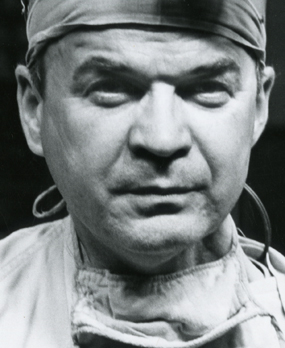How has he transformed the scene?
Born in Minneapolis, Minnesota in 1918, Dr. C. Walton Lillehei was truly a “surgical giant” of the 20th century, and a renowned innovator in the field of open-heart surgery.
In 1954, Lillehei and his associates rocked the international medical community by successfully using cross-circulation in surgery at the University of Minnesota Hospital: linking the circulatory system of a healthy individual to that of a patient whose heart is stopped to allow surgical repair. The first patient in whom the procedure was used survived for 18 days; the next two made excellent recoveries, and Lillehei’s team proceeded to conduct a total of 45 cardiac surgeries using the procedure in the following year. Although there were notable losses, their successes nevertheless revived hope in the potential of open-heart surgery and brought a tidal wave of advancements in treatment of cardio-thoracic defects.
“Forever an inspiring, memorable, and brilliant cardiac surgeon.”
Dr. John Kirklin, Society of Thoracic Surgeons
In a 1979 interview with Dr. W. Gerald Rainer for the Cardiothoracic Surgery Network, Lillehei pondered the set of conditions that may have created a climate for surgical breakthroughs to occur at the University of Minnesota. “As I look back, there seems to me far more large numbers of institutions which were far better equipped in terms of having worked on the problem longer, perhaps the staff were more prestigious, particularly some of the universities in the East. People have often asked why did it start in Minnesota, and I think that probably, as I look back, there are two basic reasons. One is — we had excellent facilities in the sense that the world’s first heart hospital was built in Minnesota and opened its doors, actually, in March 1951. The other, I think, was the presence of Dr. Wangensteen as Chairman, Department of Surgery… Basically, I refer to the fact that he had an unusual knack of spotting talent in people who didn’t even know they had talent at all. And many of those people that he selected as residents were rejects from other places because they didn’t fit the conventional mold of a surgical fellow. But, in Dr. Wangensteen’s eyes, they had some particular thing that he thought was very favorable to surgery.”
Aside from a half-dozen years in New York as Professor and Chairman of the Department of Surgery at Cornell Medical Center (1967–74), Lillehei devoted his attentions to work within the Minnesota bio-medical community. As clinical professor and surgeon at the University of Minnesota, and later Medical Director of St. Jude Medical’s Heart Valve Division, he pioneered life-changing surgical devices and methods, including work with colleagues to develop a bubble oxygenator that made the cross-circulation technique obsolete; refinements in the use of hypothermia to allow open-heart procedures that would otherwise have been impossible; and work on design and implantation of artificial heart valves. Lillehei further improved surgical outcomes with an external pacemaker, then initiated an historic conversation with a young Earl Bakken that famously led to the first wearable, transistorized pacemaker and the subsequent rise of Medtronic.
Lillehei personally trained and directly influenced a generation of cardiac researchers and surgeons, thereby changing the very landscape of human health. Among his protégés was Christiaan Barnard, who would famously perform the first successful heart transplant in South Africa in 1967.
Having earned the titles of “father of open-heart surgery” and “King of Hearts,” Lillehei died in July of 1999. In his honor, his wife Kaye helped to establish the Lillehei Heart Institute, which continues his work through support of cardiovascular and respiratory research and scholarships to aspiring students. But his greatest legacy is in the steady beat of hearts around the globe, many of which would have fallen still prematurely if not for the ingenuity, intellect, tenacity, and raw courage of C. Walton Lillehei.
Find out more about the Lillehei Heart Institute: www.lhi.umn.edu/

